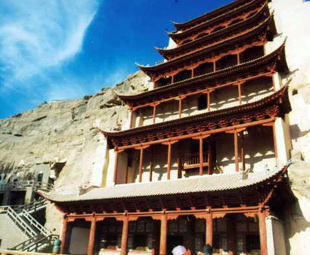Kumtag, China's sixth largest desert, is expanding by one to four meters eastward annually. The expansion poses a threat to the Mogao Grottoes, also known as the Caves of 1,000 Buddhas, in northwestern Gansu Province.
The nearest floating desert dune is only five km away from Dunhuang City, where the grottoes are located, said Gao Hua, head of the city tourism administration.
A scientific research group has just concluded China's first comprehensive environmental survey of the stark desert. They found it to be expanding in all directions, posing direct threats to the local grassland, oasis, nature reserves and the caves, which are a UNESCO-listed world heritage site.
Fifteen Chinese scientists trekked across the desert for 14 days to collect first-hand geological data, and to research hydrology, soil conditions, vegetation and environment in the desert.
Wang Jihe, head of the Gansu Desertification Prevention Bureau and also a member of the research group, told Xinhua that the desert is spreading its stretches of 2,500 square km between Lop Nur of northwest China's Xinjiang Uygur Autonomous Region and Dunhuang City.
Kumtag's means "sand hill" in Uygur. As its name suggests, it overhangs the small oasis in Dunhuang, which has nurtured an ancient culture dating back to 336 AD in the arid region.
Monitoring by the Gansu Provincial Forestry Bureau shows that the desert has devoured 6.7 square km of arable land per year in Nanhu County, Dunhuang's fringe to confront the desert invasion.
Dunhuang is a city of 31,200 square km, of which 90 percent has surrendered to desertification.
The central and local governments for the reforestation and desert control have appropriated funds to guard the ancient heritage sit. The effort, though, is weak, compared with the austere ecological degradation. The full-scale scientific research has been seen as an important part of the integrated efforts to curb the desertification.
UNESCO listed the Mogao Grottoes, one of China's most popular tourist destinations, as a world heritage site in 1987. Altogether 735 caves have been found and frescos on the inside walls cover an area of 45,000 square meters. The caves also hold 2,400 colored Buddha statues.
(Xinhua News Agency October 8, 2007)







